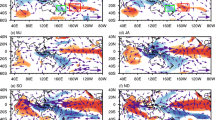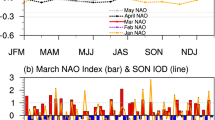Abstract
To investigate the relationship between autumn Indian Ocean Dipole (IOD) events and the subsequent winter precipitation in Southeast China (SEC), observed fields of monthly precipitation, sea surface temperature (SST) and atmospheric circulation are subjected to a running and a maximum correlation analysis. The results show a significant change of the relevance of IOD for the early modulation of SEC winter precipitation in the 1980s. After 1980, positive correlations suggest prolonged atmospheric responses to IOD forcing, which are linked to an abnormal moisture supply initiated in autumn and extended into the subsequent winter. Under global warming two modulating factors are relevant: (1) an increase of the static stability has been observed suppressing vertical heat and momentum transports; (2) a positive (mid-level) cloud-radiation feedback jointly with the associated latent heating (apparent moisture sink Q2) explains the prolongation of positive as well as negative SST anomalies by conserving the heating (apparent heat source Q1) in the coupled atmosphere–ocean system. During the positive IOD events in fall (after 1980) the dipole heating anomalies in the middle and lower troposphere over the tropical Indian Ocean are prolonged to winter by a positive mid-level cloud-radiative feedback with latent heat release. Subsequently, thermal adaptation leads to an anticyclonic anomaly over Eastern India overlying the anomalous cooling SST of the tropical Eastern Indian Ocean enhancing the moisture flow from the tropical Indian Ocean through the Bay of Bengal into South China, following the northwestern boundary of the anticyclonic circulation anomaly over east India, thereby favoring abundant precipitation in SEC.












Similar content being viewed by others
References
Ackerman TP, Liou KN, Valero FPJ, Pfister L (1988) Heating rates in tropical anvils. J Atmos Sci 45:1606–1623
Ashok K, Guan Z, Yamagata T (2001) Impact of the Indian Ocean Dipole on the relationship between the Indian monsoon rainfall and ENSO. Geophys Res Lett 26:3001–3004
Ashok K, Chan WL, Motoi T, Yamagata T (2004a) Decadal variability of the Indian Ocean dipole. Geophys Res Lett 31:L24207. doi:10.1029/2004GL021345
Ashok K, Chan W-L, Motoi T, Yamagata T (2004b) Decadal variability of the Indian Ocean dipole. Geophys Res Lett 31(24):L24207. doi:10.1029/2004GL021345
Behera SK, Yamagata T (2003) Influence of the Indian Ocean Dipole on the Southern Oscillation. J Meteorol Soc Jpn 81:169–177
Behera SK, Luo J-J, Masson S, Delecluse P, Gualdi S, Navarra A, Yamagata T (2005) Paramount impact of the Indian Ocean dipole on the East African short rains: ACGCM study. J Clim 18:4514–4530
Black E, Slingo J, Sperber KR (2003) An observational study of the relationship between excessively strong short rains in coastal East Africa and Indian Ocean SST. Mon Weather Rev 131:74–94
Bordi I, Sutera A (2001) Fifty years of precipitation: some spatially remote teleconnnections. Water Resour Manag 15:247–280
Bretherton CS, Wyant MC (1997) Moisture transport, lower-tropospheric stability, and decoupling of cloud-topped boundary layers. J Atmos Sci 54:148–167
Cai W, Cowan T, Raupach M (2009a) Positive Indian Ocean dipole events precondition southeast Australia bushfires. Geophys Res Lett 36:L19710
Cai W, Cowan T, Sullivan A (2009b) Recent unprecedented skewness towards positive Indian Ocean dipole occurrences and its impact on Australian rainfall. Geophys Res Lett 36:L11705
Cai W, Zheng X-T, Weller E, Collins M, Cowan T, Lengaigne M, Yu W, Yamagata T (2013) Projected response of the Indian Ocean dipole to greenhouse warming. Nat Geosci 6:999–1007
Czaja A, Frankignoul C (2002) Observed impact of north Atlantic SST anomalies on the north Atlantic oscillation. J Clim 15:606–623
Dahms E, Borth H, Lunkeit F, Fraedrich K (2011) ITCZ splitting and the influence of large-scale eddy fields on the tropical mean state. J Meteorol Soc Jpn 89(5):399–411
Ding RQ, Ha KJ, Li JP (2010) Interdecadal shift in the relationship between the East Asian summer monsoon and the tropical Indian Ocean. Clim Dyn 34:1059–1071
Du Y, Xie SP (2008) Role of atmospheric adjustments in the tropical Indian Ocean warming during the 20th century in climate models. Geophys Res Lett 35:L08712. doi:10.1029/2008GL033631
Fraedrich K, Jansen H, Luksch U, Lunkeit F (2005) The planet simulator: towards a user friendly model. Meteorol Z 14:299–304
Frankignoul C (1985) Sea surface temperature anomalies, planetary waves and air–sea feedback in the middle latitudes. Rev Geophys 23:357–390
Frankignoul C, Chouaib N, Liu ZY (2011) Estimating the observed atmospheric response to SST anomalies: maximum covariance analysis, generalized equilibrium feedback assessment, and maximum response estimation. J Clim 24:2523–2539
Gill AE (1980) Some simple solutions for heat-induced tropical circulation. Q J R Meteorol Soc 106(449):447–462
Guan Z, Yamagata T (2003) The unusual summer of 1994 in East Asia: IOD teleconnections. Geophys Res Lett 30:1544–1547 (J Clim 21:2035–2046)
Hasselmann K (1976) Stochastic climate models. I. Theory. Tellus 28:473–485
Hu YY, Zhou C, Liu JP (2011) Observational evidence for the poleward expansion of the Hadley circulation. Adv Atmos Sci 28(1):33–44
Ihara C, Kushnir Y, Cane MA (2008) Warming trend of the Indian Ocean SST and Indian Ocean dipole from 1880 to 2004. J Clim 21(10):2035–2046
Keyantash J, Dracup JA (2002) The quantification of drought: an evaluation of drought indices. Bull Am Meteorol Soc 83:1167–1180
Knutson TR, Manabe S (1995) Time-mean response over the tropical Pacific to increase CO2 in a coupled Ocean–atmosphere model. J Clim 8:2181–2199
Knutson TR, Manabe S, Gu D (1997) Simulated ENSO in a global coupled ocean-atmosphere model: multidecadal amplitude modulation and CO2 sensitivity. J Clim 10:138–161
Lau NC, Nath MJ (2004) Coupled GCM simulation of atmosphere–ocean variability associated with zonally asymmetric SST changes in the tropical Indian Ocean. J Clim 17:245–265
Li C, Mu M (2001) The influence of the Indian Ocean Dipole on atmospheric circulation and climate. Adv Atmos Sci 18:831–843
Li T, Wang B, Chang CP, Zhang Y (2003) A theory for the Indian Ocean dipole-zonal mode. J Atmos Sci 60:2119–2135
Li CY, Zhou W, Wang X (2006) Decadal/Interdecadal variations of ocean temperature and its impacts on climate. Adv Atmos Sci 23:964–981
Lorenz EN (1957) Static stability and atmospheric energy. Scientific Report No. 9, Massachusetts Institute of Technology, pp 1–41
Lu J, Vecchi GA, Reichler T (2007) Expansion of the Hadley cell under global warming. Geophys Res Lett 34:L06805. doi:10.1029/2006GL028443
Lu J, Chen G, Frierson DMW (2008) Response of the zonal mean atmospheric circulation to El Niño versus global warming. J Clim 21:5835–5851
Mace GG, Benson S, Kato S (2006) Cloud radiative forcing at the Atmospheric Radiation Measurement Program Climate Research Facility: 2. Vertical redistribution of radiant energy by clouds. J Geophys Res 111:D11S91. doi:10.1029/2005JD005922
Manabe S, Stouffer RJ (1993) Century-scale effects of increased atmospheric CO2 on the ocean–atmosphere system. Nature 364:215–218
McKee TB, Doesken NJ, Kleist J (1993) The relationship of drought frequency and duration to time scales. In: Proceedings of the 8th conference on applied climatology, 17–22 January, Anaheim, CA, American Meteorological Society, Boston, MA, pp 179–184
Meyers GA, McIntosh PC, Pigot L, Pook MJ (2007) The years of El Niño, La Niña, and interactions with the tropical Indian Ocean. J Clim 20:2872–2880
Miller RL (1997) Tropical thermostats and low cloud cover. J Clim 10:409–440
Nitta T, Yamada S (1989) Recent warming of tropical sea surface temperature and its relationship to the Northern Hemisphere circulation. J Meteorol Soc Jpn 67:375–383
Park S, Alexander MA, Deser C (2006) The impact of cloud radiative feedback, remote ENSO forcing, and entrainment on the persistence of North Pacific Sea surface temperature anomalies. J Clim 19:6243–6261
Phlips PJ, Gill AE (1987) An analytic model of the heat-induced tropical circulation in the presence of a mean wind. Q J R Meteorol Soc 113:213–236
Preisendorfer RW, Barnett TP (1983) Numerical model-reality intercomparison tests using small-sample statistics. J Atmos Sci 40:1884–1896
Saji NH, Yamagata T (2003) Possible impacts of Indian Ocean Dipole mode events on global climate. Clim Res 25:151–169
Saji NH, Goswami BN, Vinayachandran PN, Yamagata T (1999) A dipole mode in the tropical Indian Ocean. Nature 401(6751):360–363
Seidel DJ, Fu Q, Randel WJ, Reichler TJ (2008) Widening of the tropical belt in a changing climate. Nat Geosci 1(1):21–24
Song QN, Vecchi GA, Rosati A (2007) Indian Ocean variability in the GFDL CM2 coupled climate model. J Clim 20:2895–2916
Tian BJ, Ramanathan V (2002) Role of tropical clouds in surface and atmospheric energy budget. J Clim 15:296–305
Tozuka T, Luo JJ, Masson S, Yamagata T (2007) Decadal modulations of the Indian Ocean Dipole in the SINTEX-F1 coupled GCM. J Clim 20:2881–2894
Trenberth KE (1990) Recent observed interdecadal climate changes in the Northern Hemisphere. Bull Am Meteorol Soc 71:988–993
von Storch H, Zwiers FW (1999) Statistical analysis in climate research. Cambridge University Press, Cambridge
Wu Y, Ting M, Seager R, Huang HP, Cane MA (2011) Changes in storm tracks and energy transports in a warmer climate simulated by the GFDL CM2. 1 model. Clim Dyn 37(1):53–72
Xie SP, Hu K, Hafner J (2009) Indian Ocean capacitor effect on Indo-western Pacific climate during the summer following El Niño. J Clim 22:730–747
Yamagata TS, Behera K, Guan Z (2003) The role of the Indian Ocean in climate forecasting with a particular emphasis on summer conditions in East Asia. In: ECMWF workshop proceedings, pp 102–114
Yanai M, Esbensen S, Chu JH (1973) Determination of bulk properties of tropical cloud clusters from large-scale heat and moisture budgets. J Atmos Sci 30:611–627
Yang JL, Liu Q, Liu ZY (2010) Linking observations of the Asian monsoon to the Indian Ocean SST: possible roles of Indian Ocean basin mode and dipole mode. J Clim 23:5889–5902
Yuan Y, Yang H, Zhou W, Li C (2008) Influences of the Indian Ocean Dipole on the Asian 5 summer monsoon in the following year. Int J Climatol 28:1849–1859
Zhang Y, Sperber KR, Boyle JS (1997) Climatology and interannual variation of the East Asian Winter Monsoon: results from the 1979-1995 NCEP/NCAR reanalysis. Mon Weather Rev 125:2605–2619
Zhang L, Sielmann F, Fraedrich K, Zhu X, Zhi X (2015) Variability of winter extreme precipitation in Southeast China: contributions of SST anomalies. Clim Dyn 45:2557–2570. doi:10.1007/s00382-015-2492-6
Zheng XT, Xie SP, Vecchi GA, Liu Q, Hafner J (2010) Indian Ocean Dipole response to global warming: analysis of ocean-atmospheric feedbacks in a coupled model. J Clim 23:1240–1253
Zheng J, Liu QY, Wang CZ (2013) Impact of heating anomalies associated with rainfall variations over the Indo-Western Pacific on Asian atmospheric circulation in winter. Clim Dyn 40:2023–2033
Zhi XF (2001) Interannual variability of the Indian summer monsoon and its modeling with a zonally symmetric 2D model. Shaker Verlag, Aachen 152
Acknowledgments
This study acknowledges the support of the National Natural Science Foundation of China (41305081), National Basic Research Program “973” of China (2012CB955204), Max Planck Institute for Meteorology (MPI-M) fellowship, and Priority Academic Program Development of Jiangsu Higher Education Institutions (PAPD). Our special thanks go to Dr. Frank Lunkeit for his support in setting up the GCM experiments and for several helpful discussions. The authors finally wish to thank two anonymous reviewers for their constructice comments.
Author information
Authors and Affiliations
Corresponding author
Appendix
Appendix
Following Yanai et al. (1973), the approximations of atmospheric apparent heat source Q1 and apparent moisture sink Q2 are,
where T, V, ω, θ, q represent air temperature, horizontal wind, vertical velocity, potential temperature and specific humidity respectively, with the following constants K = 0.286, Cp = 1004 J/kg K. L is calculated as below,
And the vertical integrals of atmospheric apparent heat source 〈Q1〉 and apparent moisture sink 〈Q2〉 are calculated as below,
where P s represents surface pressure, 100 and 300 are pressure levels in hPa; g is the gravitational constant (9.81 m/s2).
Rights and permissions
About this article
Cite this article
Zhang, L., Sielmann, F., Fraedrich, K. et al. Atmospheric response to Indian Ocean Dipole forcing: changes of Southeast China winter precipitation under global warming. Clim Dyn 48, 1467–1482 (2017). https://doi.org/10.1007/s00382-016-3152-1
Received:
Accepted:
Published:
Issue Date:
DOI: https://doi.org/10.1007/s00382-016-3152-1




